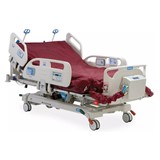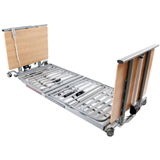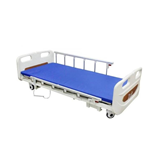7 Essential Features to Consider in a Hospital Beds
When it comes to patient care, having the right hospital bed is crucial. The right bed can significantly impact a patient's comfort, recovery speed, and safety. Hospital beds must also be easy for caregivers and suitable for the hospital environment.
This guide includes the top features to consider when choosing a hospital bed. It ensures you know how to select a bed that meets your needs.
Types of Hospital Beds
Hospital beds are designed to be highly versatile, allowing patients to adjust them to meet their changing needs. There are three primary types of hospital beds: manual, semi-electric, and fully electric. Additionally, there are specialised types of medical beds that cater to specific needs.
Manual Hospital Bed
Manual hospital beds are adjusted using hand cranks to change the height, head, and foot sections. The hand cranks are usually located at the foot of the bed, and someone with enough physical strength is needed to operate them. These beds are the most affordable option, and they are often used when budget is limited or patients have stable conditions that do not require frequent adjustments.
Semi-Electric Hospital Bed
Semi-electric hospital beds combine manual and electric functionalities. The bed's head and foot sections are adjusted using an electric motor, which patients or caregivers can control via a hand pendant. This allows for easier adjustments without physical energy. However, the bed's overall height still requires manual adjustment with a hand crank.
Fully-Electric Hospital Bed
Fully-electric hospital beds offer the highest level of convenience and flexibility. These beds are equipped with electric motors that allow the patient or caregiver to adjust the head and foot sections and the entire height and positioning of the bed, all through hand control. Some fully electric beds also offer advanced positioning options.
7 Features to Look for in a Hospital Bed
-
Customisable Comfort
Customising hospital beds can greatly benefit elderly patients, those recovering from surgery, bariatric patients, and individuals with specific medical needs. These beds improve comfort, help manage pain, and increase mobility, making patients more independent. Features like bed rails reduce the risk of falls, especially for those with mobility issues.
-
Safety
When it comes to hospital beds, safety is a top priority. To prevent falls, hospital beds should have features such as low bed heights and padded sides. Low beds reduce the distance a patient might fall, while padded side rails provide support and a protective barrier.
-
Bed Exit Alarms
Bed exit alarms add a layer of safety by alerting carers when a patient attempts to leave the bed. These alarms can quickly notify staff, allowing them to assist the patient and avoid potential accidents.
-
Mobility Assistance
Beds are equipped with mobility tools, such as grab bars, for patients with limited mobility. These features help patients get in and out of bed more efficiently and safely, reducing the need for constant carer support.
-
Easy Operation
Look for bed features that can help the caregiver care for the patients. For example, long-term care beds offer more options for adjustments and are designed to minimise physical activity on the caregiver.
-
Bed Hygiene
Hospital beds require regular cleaning to maintain a sanitary environment. Choose beds with surfaces and materials that are easy to clean and resist staining and wear. For convenience, use removable parts and washable covers.
Also consider materials that stop bacteria from growing to provide extra protection. Popular materials for hospital beds include powder-coated steel and antimicrobial vinyl, which are durable and easy to clean. These materials can be wiped down with disinfectants, resist staining, and help prevent infections to maintain hospital hygiene.
-
Durability and Build Quality
When choosing a hospital bed, it is crucial to prioritise durability and build quality, especially for beds intended for bariatric patients or long-term use. A strong frame ensures the bed can withstand daily wear and tear, providing reliable support.
The quality of the bed directly affects the patient's comfort and overall experience. Research different manufacturers and carefully consider the features you need to ensure you get a durable, high-quality bed that provides the best value.
In summary, The right bed can significantly affect a patient's recovery, comfort, and overall safety. By carefully considering the different types of hospital beds and the specific features that enhance safety, ease of use, and durability, healthcare providers can ensure that they are well-equipped to meet the diverse needs of their patients. This guide has provided valuable insights to help you make informed decisions, ultimately improving the quality of care and patient satisfaction.
Ready to make the best choice for your facility?
- Compare prices, specifications, and features to find the right hospital bed.
- Assess the full cost by evaluating maintenance and consumables.
- Analyse suppliers and reviews to ensure credibility and reliability.
Start comparing now to find the perfect hospital bed that meets your needs and enhances patient care. Compare hospital beds on MedicalSearch now!
FAQ:
Q: What are the different types of hospital beds available?
A: Hospital beds generally fall into three categories: manual, semi-electric, and fully electric. Manual beds are adjusted using hand cranks, semi-electric beds use a combination of manual and electric controls, and fully electric beds offer complete electric control over all bed adjustments.
Q: Can hospital beds help with patient mobility?
A: Yes, many hospital beds are designed with mobility assistance features such as grab bars and adjustable heights. These features can help patients get in and out of bed more safely and independently, reducing the need for caregiver assistance.
Q: What materials are best for hospital beds to ensure hygiene?
A: Hospital beds should be made from durable, easy-to-clean materials like powder-coated steel and antimicrobial vinyl. These materials resist staining and wear and can be wiped down with disinfectants to maintain a sanitary environment and prevent infections.

(1)(1).jpg)

















